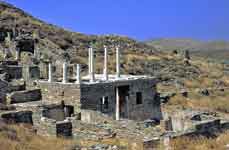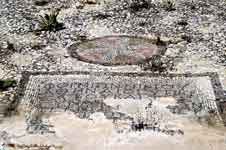.
Administrative Region : North Aegean
Regional unit : Mykonos
Δῆλος, νῆσος μία τῶν Κυκλάδων. Δῆλον ἐκυκλώσαντο καὶ οὔνομα Κυκλάδες εἰσίν. ἢ παρὰ τὰς γονὰς [ἢ μαντείας]. ἱερὸν γὰρ Δῆλος τοῦ Ἀπόλλωνος, τοῦ θεοῦ πρῶτον ἐν αὐτῇ γενομένου. ἢ διὰ τὰς μαντείας· δηλοῦσα γὰρ ἦν τὰ δυσεύρετα. ἐκαλεῖτο δὲ Κύνθος ἀπὸ Κύνθου τοῦ Ὠκεανοῦ, καὶ Ἀπόλλων Κύνθιος. καὶ Ἀστερία καὶ Πελασγία καὶ Χλαμυδία. τινὲς δὲ ὅτι Ζάκυνθος ἐκαλεῖτο, κακῶς εἰδότες. κεκλῆσθαι δὲ αὐτὴν καὶ Σκυθίδα Νικάνωρ φησίν. ἐξ αὐτοῦ Δήλιος καὶ Δηλία καὶ Δηλιάς. καὶ Δηλίτης ὁ εἰς Δῆλον ἐρχόμενος χορός, Καλλίμαχος τρίτῳ. καὶ Δηλιακός τὸ κτητικόν. Stephanus of Byzantium
The island of Delos (Greek: Δήλος, [ˈðilos]; Attic Δῆλος, Doric Δᾶλος), isolated in the centre of the roughly circular ring of islands called the Cyclades, near Mykonos, is one of the most important mythological, historical and archaeological sites in Greece. The excavations in the island are among the most extensive in the Mediterranean; ongoing work takes place under the direction of the French School at Athens and many of the artifacts found are on display at the Archaeological Museum of Delos and the National Archaeological Museum of Athens.
Delos had a position as a holy sanctuary for a millennium before Olympian Greek mythology made it the birthplace of Apollo and Artemis. From its Sacred Harbour, the horizon shows the two conical mounds (image below) that have identified landscapes sacred to a goddess in other sites: one, retaining its pre-Greek name Mount Kynthos,[1] is crowned with a sanctuary of Dionysus.
Established as a cult centre, Delos had an importance that its natural resources could never have offered. In this vein Leto, searching for a birthing-place for Artemis and Apollo, addressed the island:
Delos, if you would be willing to be the abode of my son Phoebus Apollo and make him a rich temple --; for no other will touch you, as you will find: and I think you will never be rich in oxen and sheep, nor bear vintage nor yet produce plants abundantly. But if you have the temple of far-shooting Apollo, all men will bring you hecatombs and gather here, and incessant savour of rich sacrifice will always arise, and you will feed those who dwell in you from the hand of strangers; for truly your own soil is not rich.
—Homeric Hymn to Delian Apollo
History
The island of Delos, Carl Anton Joseph Rottmann,1847
Reconstructed side on the south wester part of the island
Investigation of ancient stone huts found on the island indicate that it has been inhabited since the 3rd millennium BC. Thucydides identifies the original inhabitants as piratical Carians who were eventually expelled by King Minos of Crete.[2] By the time of the Odyssey the island was already famous as the birthplace of the twin gods Apollo and Artemis. (Although there seems to be some confusion of Artemis' birthplace being either Delos or the island of Ortygia.) Indeed between 900 BC and AD 100, sacred Delos was a major cult centre, where Dionysus is also in evidence as well as the Titaness Leto, mother of the above mentioned twin deities. Eventually acquiring panhellenic religious significance, Delos was initially a religious pilgrimage for the Ionians.
A number of "purifications" were executed by the city-state of Athens in an attempt to render the island fit for the proper worship of the gods. The first took place in the 6th century BC, directed by the tyrant Pisistratus who ordered that all graves within sight of the temple be dug up and the bodies moved to another nearby island. In the 5th century, during the 6th year of the Peloponnesian war and under instruction from the Delphic Oracle, the entire island was purged of all dead bodies. It was then ordered that no one should be allowed to either die or give birth on the island due to its sacred importance and to preserve its neutrality in commerce, since no one could then claim ownership through inheritance. Immediately after this purification, the first quinquennial festival of the Delian games were celebrated there.[3]
After the Persian wars the island became the natural meeting-ground for the Delian League, founded in 478 BC, the congresses being held in the temple (a separate quarter was reserved for foreigners and the sanctuaries of foreign deities.) The League's common treasury was kept here as well until 454 BC when Pericles removed it to Athens.[4]
Since 1872 the École Française d'Athènes ("French School of Athens") has been excavating the island, the complex of buildings of which compares with those of Delphi and Olympia.
The island had no productive capacity for food, fiber, or timber, with such being imported. Limited water was exploited with an extensive cistern and aqueduct system, wells, and sanitary drains. Various regions operated agoras (markets). The largest slave market in the larger region was also maintained here.
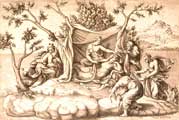
Leto (Latona) and the Birth of Apollo and Artemis on Delos, Diana Scultori
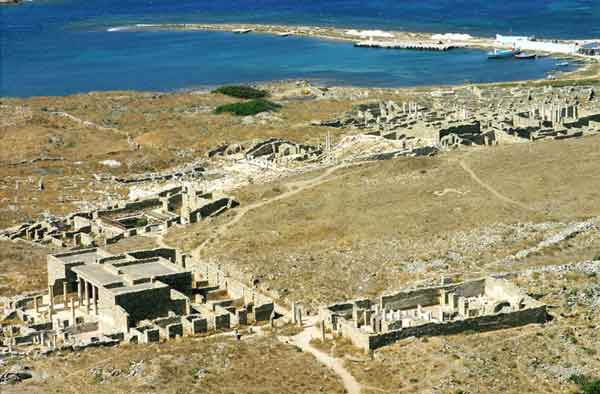
Delos [Source]
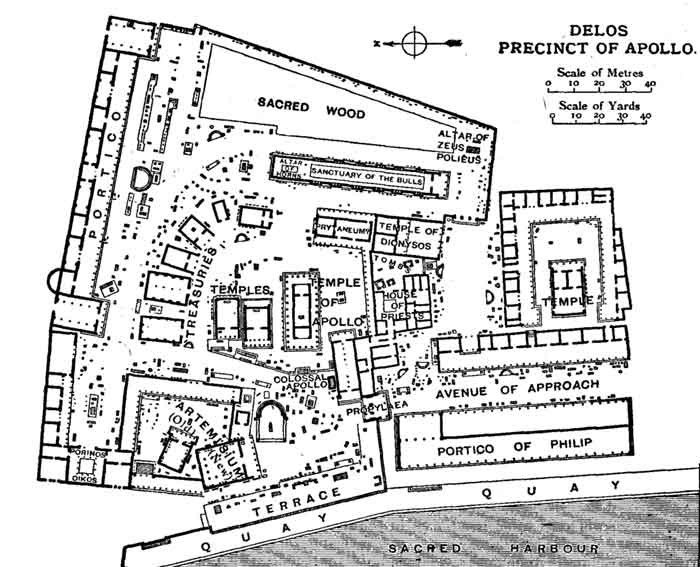
In 1990, UNESCO inscribed Delos on the World Heritage List, citing it as the "exceptionally extensive and rich" archaeological site which "conveys the image of a great cosmopolitan Mediterranean port".[5]
Landmarks
The small Sacred Lake in its circular bowl, now intentionally left dry by the island's caretakers to suppress disease spreading bacteria, is a topographical feature that determined the placement of later features.
The Minoan Fountain was a rectangular public well hewn in the rock, with a central column; it formalized the sacred spring in its present 6th century BC form, reconstructed in 166 BC, according to an inscription. Tightly-laid courses of masonry form the walls; water can still be reached by a flight of steps that fill one side.
There are several market squares. The Hellenistic Agora of the Competaliasts by the Sacred Harbour retains the postholes for market awnings in its stone paving. Two powerful Italic merchant guilds dedicated statues and columns there.
The Temple of the Delians, dedicated to Apollo, is a classic example of the Doric order; a pen-and-wash reconstruction of the temple is illustrated at Doric order
The Terrace of the Lions also dedicated to Apollo by the people of Naxos shortly before 600 BC, had originally nine to twelve squatting, snarling marble guardian lions along the Sacred Way; one is inserted over the main gate to the Venetian Arsenal. The lions create a monumental avenue comparable to Egyptian avenues of sphinxes. (There is a Greek sphinx in the Delos Museum.) Today only seven of the original lions remain.
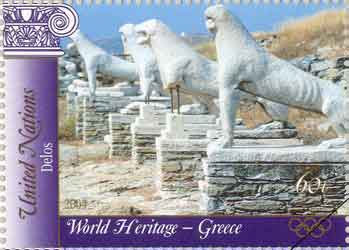
The meeting hall of the Poseidoniasts of Beirut housed an association of merchant, warehousemen, shipowners and innkeepers during the early years of Roman hegemony, late 2nd century BC. To their protective triad of Baal/Poseidon, Astarte/Aphrodite and Eshmun/Asklepios, they added Roma.
The platform of the Stoivadeion dedicated to Dionysus bears a statue of the god of wine and the life-force. On either side of the platform, a pillar supports a colossal phallus, the symbol of Dionysus. The southern pillar, which is decorated with relief scenes from the Dionysiac circle, was erected ca. 300 BC to celebrate a winning theatrical performance. The statue of Dionysus was originally flanked by those of two actors impersonating Paposilenoi (conserved in the Archaeological Museum of Delos). The marble theatre is a rebuilding of an older one, undertaken shortly after 300 BC.
The Doric Temple of Isis was built on a high over-looking hill at the beginning of the Roman period to venerate the familiar trinity of Isis, the Alexandrian Serapis and Anubis.
The Temple of Hera, ca 500 BC, is a rebuilding of an earlier Heraion on the site.
The House of Dionysus is a luxurious 2nd century private house named for the floor mosaic of Dionysus riding a panther.
The House of the Dolphins is similarly named from its atrium mosaic, where erotes ride dolphins; its Phoenician owner commissioned a floor mosaic of Tanit in his vestibule.
The Delos Synagogue, the oldest synagogue known today.
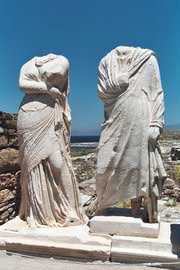
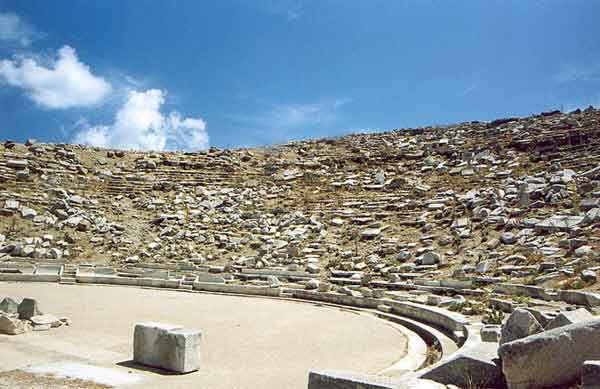
Delos Theater [Source]

Delos, Mount Kythnos, Isis Temple |
|

Apollo Temple , Delos Sculptures

Current population
The 2001 Greek census reported a population of 14 inhabitants on the island. The island is administratively a part of the municipality of Mýkonos.
See also
Delian League
Delian problem
French Archaeological School at Athens
History of the Cyclades
References
^ The combination -nth- is a marker for pre-Greek words: Corinth, menthos, labyrinth, etc. A name Artemis and even Diana retained was Cynthia.
^ Thucydides, I,8.
^ Thucydides, III,104.
^ Thucydides, I,96.
^ whc.unesco.org

21 : Statue of a Nike. Parian marble. Found in Delos.

3335 : Group of Aphrodite, Pan and Eros from Delos. Parian marble

1829 : Statuette of Artemis from Delos. Parian marble.
Further reading
Claude Vial, Inscriptions de Délos. Index, tome II: les Déliens (Paris: De Boccard, 2008).
| Municipal Community Mykonioi |
|---|
| Agios Ioannis Diakoftis (Άγιος Ιωάννης Διακόφτης Μυκόνου, ο |
| Agios Stefanos (Άγιος Στέφανος Μυκόνου, ο) |
| Delos (Δήλος Μυκόνου, η (νησίδα)) |
| Kavouras (Κάβουρας Μυκόνου, ο (νησίδα)) |
| Klouvas (Κλουβάς Μυκόνου, ο) |
| Krommydi (Κρομμύδι Μυκόνου, το (νησίδα)) |
| Marmaronisi (Μαρμαρονήσιο Μυκόνου, το (νησίδα)) |
| Baos (Μπάος Μυκόνου, ο (επί της νήσου Αγίου Γεωργίου)) |
| Mykonos (Μύκονος, η) |
| Ornos (Ορνός Μυκόνου, ο) |
| Platys Gialos (Πλατύς Γιαλός Μυκόνου, ο) |
| Plintri (Πλιντρί Μυκόνου, το) |
| Rineia ( Ρήνεια Μυκόνου, η (νησίδα)) |
| Sfontili (Σφοντήλι Μυκόνου, το (νησίδα)) |
| Tourlos (Τούρλος Μυκόνου, ο) |
| Faros Armenistis (Φάρος Αρμενιστής Μυκόνου, ο) |
| Psarrou (Ψαρρού Μυκόνου, η) |
A - B - C - D - E - F - G - H - I - J - K - L - M-
N - O - P - Q - R - S - T - U - V - W - X - Y - Z
Greece :
A - B - C - D - E - F - G - H - I - J - K - L - M -
N - O - P - Q - R - S - T - U - V - W - X - Y - Z
| Ancient Greece
Science, Technology , Medicine , Warfare, , Biographies , Life , Cities/Places/Maps , Arts , Literature , Philosophy ,Olympics, Mythology , History , Images Medieval Greece / Byzantine Empire Science, Technology, Arts, , Warfare , Literature, Biographies, Icons, History Modern Greece Cities, Islands, Regions, Fauna/Flora ,Biographies , History , Warfare, Science/Technology, Literature, Music , Arts , Film/Actors , Sport , Fashion --- |
Retrieved from "http://en.wikipedia.org/"
All text is available under the terms of the GNU Free Documentation License


